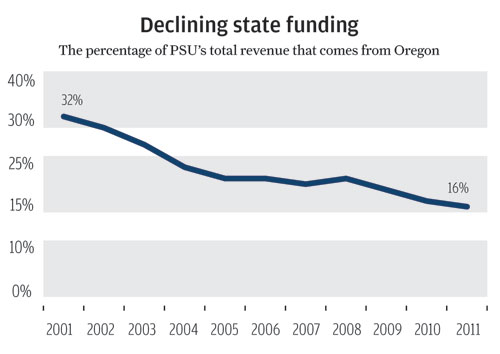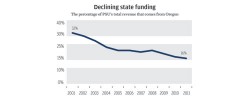
In panning out the Oregon state budget for 2011, legislators made significant cuts in funding to state universities. Whereas once state university expenditures were mostly covered by state subsidies, now the opposite is true, with most expenses covered by tuition and fees. With a dramatic 23 percent decrease in state funding and a continuing harsh economic climate, Portland State administrators set about devising a proposal for a new budget model by which to evaluate financial decisions in the coming years.
On June 11, 2011, the Financial Futures Taskforce completed a financial report that evaluated which direction PSU should take to make spending more efficient and effective. A reduction in state funding and the prospect of an estimated $10 million rise in expenses for 2012–13 prompted the adoption of a performance-based budget model. Since developing the new model, PSU has moved forward, calculating and documenting all of PSU’s expenses and allocation of revenues.
Once sufficient data is collected to build the model, the university will spend the 2012–13 academic year running the numbers in a shadow-model function, while the current budget model remains in place. To collect data, PSU will evaluate each school of the university by counting how much tuition each unit raises against its expenses. This creates greater clarity for the administration to see where revenue is being generated and where expenses are the highest. The new model is expected to be in place and running by the 2013–14 academic year.
Addressing the decrease in state funding, Provost and Vice President for Academic Affairs Roy Koch said: “Now we are much more like any other kind of enterprise where the money comes in from the outside. We need to stop thinking like a state agency, which is only about our allocation of resources, and start worrying about generating adequate resources and using those resources efficiently to serve the students who are paying for them.”
The rise in dependence on tuition raises concerns about the prospects of hikes in tuition. However, according to PSU Vice President for Finance and Administration Monica Rimai, tuition increases are not directly related to any current or future budget model. “Budget models neither set tuition nor save money. They merely constitute a tool for providing better information for decision-makers,” Rimai said. “The new budget model is still in development through a very iterative, all-campus process.”
In July, Sona Karentz Andrews will take over for Koch, who is retiring. As provost at the University of Wisconsin-Milwaukee, Andrews worked on a similar shift to decentralized budget modeling. As provost at Boise State, Andrews supported moving the entire Idaho State University system over to a type of performance-based budget model.
“I believe this is a very positive direction for Portland State,” Andrews said in an email. “We are in a time of significant financial challenge—not just at Portland State, but in public higher education in general. We cannot keep doing business as usual. We need to develop processes that allow for budget decisions to be based on a set of shared university values; a process that is transparent and ensures that we make sound decisions.”
The provost will play a major role in evaluating the new model in action, in terms of how it serves the greater body of PSU and how it affects communication between schools of the university. In regard to fears about isolation between academic units as a side effect of a decentralized budget model, Andrews said: “From what I know of where Portland State is in the process, it is premature to come to those conclusions. The provost’s role, like that of all others at the university, is to ensure that everyone works together to the benefit of students. I am not worried about losing a sense of community and equality since the provost and deans will all be working together as the academic leadership of the university to make sure that there is collaboration and no negative impact on students.”
Koch added that adopting a performance-based budget model will not lead to programs being cut for not generating enough revenue: “It’s a balancing act between making sure we have a broad array of programs to serve students and making sure that, for those programs that are more expensive, they are operating as efficiently and effectively as possible,” Koch said. “We have a mission as a public institution; we are not going to let that mission be driven by the budget.”
Koch explained that though each academic unit will be evaluated on how much revenue it generates through tuition and how that compares to costs, there will still be cross subsidization throughout the university in the hope that programs will still be available and as affordable as possible for prospective students.
“We don’t want someone to not to choose to become an engineer because it costs too much,” Koch said.

